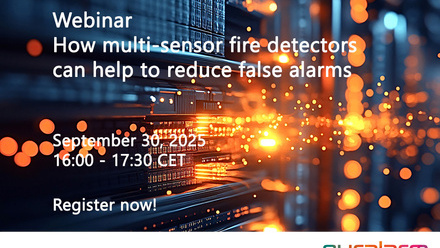EUSAS conference shows how Artificial Intelligence can support or optimise fire safety and security
The conference opened with a discussion on what Artificial Intelligence (AI) is. The general concepts as well as the history and starting blocks of AI were discussed. Also the current application fields for AI in Smart Living as well as important requirements for the realization of intelligent Smart Living services were presented. Focal point for the fire industry were the presentations during the session on the benefits and opportunities of AI for fire detection and security.
Artificial Intelligence and Fire Safety
In his presentation Guillermo Rein of the Imperial College London presented an innovative fire protection system that combines building sensors, computer modelling, and artificial intelligence (AI). It is called The Fire Navigator and aims to forecast the movement of a fire inside a large building, providing the fire brigades with essential information about flames and smoke ahead of time. It bridges the gap between fire safety and Building Information Modelling by making use of the data already produced by high-rise building sensors such as smoke and heat sensors. A fast and simple cellular automata model assimilates sensor data, and via inverse modelling and genetic algorithm techniques we uncover the ignition location, time, flame spread rate and smoke velocity. A test case with synthetic data was shown for a real iconic building in London. The Fire Navigator concept would be specially suited for the protection of higher risk buildings like highrise and hospital, or key infrastructure like tunnels and power plants.
Sensor technology
Paul van der Zanden, General Director of Euralarm, elaborated on the connection between AI and the fire industry. He took a holistic approach by defining AI as 'Technology used to add value and/or improve the outcome of an existing or new process/system'. The fire industry has a wide scope and covers many aspects. Within Euralarm fire safety is seen as an ecosystem and therefore fire safety should be part of the development process. Assuming that everything is done in the design to prevent a fire from starting there still is a chance that a fire incident will happen. A key factor which defines the impact from this incident is time. Timely detection and sensitivity for unnecessary alarms have a relation with each other. Both factors can be improved by using new technologies including AI technologies. The question is if we can use other future spin-off developments from the AI world for the fire safety world. The introduction of new sensor technologies available could be one of these spin-offs. With an example from AI sensor technology development Paul van der Zanden showed how the future fire detection can be brought to the next level.
AI-related vulnerabilities
In his presentation Ibrahim Daoudi of CNPP presented the vulnerabilities related to the use of artificial intelligence on security/safety products. There are mainly 3 categories of vulnerabilities. The first category consists of adversarial attacks where the aim is to generate data sufficiently modified to mislead the model. The second category concerns physical attacks. It is in fact based on adversarial attacks but applied to real objects. The third category is the traditional attacks on information systems leading to the poisoning of the model itself or its training data. All three the vulnerability categories were discussed and explained.
Temporal Deep Learning
Utilizing temporal information is crucial to detect smoke in video sequences. In his presentation Andreas Wellhausen of Bosch Sicherheitssysteme GmbH presented the work on temporal approaches based on Deep Learning that are applied to Video Smoke Detection. Two methods were elaborated. Firstly, a combination of convolutional neural networks (CNN) and long-short-term-memory networks (LSTM), secondly the inflated 3D architecture (i3D), which consists of 3D convolutions. These are two state-of-the-art approaches to extract spatial and temporal information out of video sequences. A new way to detect and localize smoke within such sequences was presented, called cell-wise classification. Furthermore, the advantage of temporal approaches over CNN methods, which are commonly used for detection problems in Computer Vision, was shown.
Training AI on synthetic data
Philip Dietrich of Bosch Sicherheitssysteme analysed the idea of using synthetic data to train Deep Learning Systems for Video-Based Smoke Detection algorithms. Compared to real data, gathering a large-scale database is significantly easier for synthetic data. It was shown how Deep Learning networks can be trained on synthetic videos. The results were compared with real data. As a mean of bridging the domain gap between real and synthetic data, the concept of domain adaptation will be introduced. By forcing networks to extract similar features from real and synthetic data respectively, potential artefacts in synthetic data may not be learned by the network. Experimental results support the hypothesis, that domain adaptation improves the generalization on real data.
Legislation and outlook
While the rapid adoption of AI creates exciting new opportunities for industry and individuals alike, it also poses an important question: does current laws apply to AI? Tadas Tumėnas of Orgalim discussed if and how this new technology should be regulated. He outlined the state of play of AI in Europe. He focused on the definition of AI which should be the essence of the EU legislative framework and presented the Commission’s work related to AI.
In the last presentation Lance Rütimann, chair of the Fire Section of Euralarm, said that if the fire safety industry does not take on the task of working with legislators, regulators, and standardisation bodies in defining the aforementioned regulatory landscape, then someone else will. This is because the use of Artificial Intelligence to protect lives and assets makes good sense. Understandably, the path ahead is not clear, and there are many, many questions. The fact that the results of the work of the fire safety industry makes the world a safer place for millions of people is the best motivation to set the focus on a new horizon.





